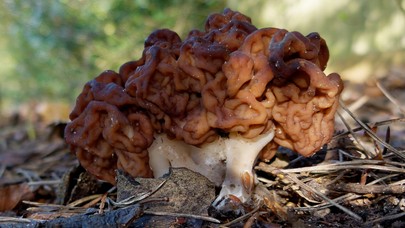Gyromitra esculenta
Description
Gyromitra esculenta, also known as the false morel or brain mushroom, is a highly poisonous fungus found in parts of Europe, North America, and Asia. It is commonly mistaken for the edible morel mushroom, which is highly prized for its culinary uses. Gyromitra esculenta can be distinguished from true morels by its brain-like appearance and the presence of irregular folds on its cap.
Consuming Gyromitra esculenta can lead to a range of symptoms including nausea, vomiting, diarrhea, headache, dizziness, and in severe cases, seizures and coma. Despite its toxic properties, G. esculenta is sometimes consumed as a delicacy in parts of Scandinavia and Eastern Europe. Traditional methods of preparing the mushroom involve boiling or soaking it in water to remove the toxin, but these methods are not always effective.
Common names: False Morel, Brain Mushroom, Rain Mushroom, Beefsteak Morel, Elephant Ears, Lorchel, Turban Fungus, German (Frühlingslorchel), Voorjaarskluifzwam (Netherlands).
Mushroom Identification
-
Cap
The cap is irregular and convoluted in shape, but generally brain-like and often somewhat lobed (although usually not saddle-shaped). It measures 1.57 to 3.15 inches (4 to 8 cm) high and 1.18 to 4.72 inches (3 to 12 cm) wide and is wrinkled and bald. The cap starts off pinkish-tan to reddish-brown but becomes darker or nearly black in age and prolonged sunlight. The undersurface is not generally exposed, close to the stem, and is tan to whitish, finely mealy.
-
Flesh
The flesh of this species is thin, brittle, and whitish to tan, with a slight or chambered structure.
-
Stem
The stem measures 1.18 to 3.54 inches (3 to 9 cm) long and 0.39 to 1.38 inches (1 to 3.5 cm) thick, and is pale yellowish-tan to rose-tinted, similar to the cap. It is usually round in cross-section but frequently folded into a figure-eight cross-section, and is bald.
-
Spore Print
Yellowish buff.
-
Habitat
This species is saprobic but has the potential to also be mycorrhizal. It is primarily found in the spring under conifers and is widely distributed across Europe and North America.
-
Microscopic Features
The spores measure 19-28 x 10-13 µ, are smooth and are fusiform or nearly ellipsoid. They are usually biguttulate with two small droplets but occasionally uniguttulate or multiguttulate. The asci are 8-spored, and the paraphyses are clavate, measuring 4-10 µ wide and are reddish to reddish-orange.
Look-Alikes
-
The cap is deeply pitted with a single hollow chamber, and its stipe is typically longer than Gyromitra esculenta's.
-
Has a creamy-white, twisted, saddle-shaped cap and a stipe with tube-like hollows running lengthwise.
-
Has a distinct saddle-shaped cap with a surface that is wavy or bumpy but not wrinkled.
Gyromitra montana
This species primarily found in the Sierra Nevada region. It is shorter and stouter than G. esculenta, with a roughly wrinkled cap that is only slightly wider than the stipe.
Gyromitra californica
It is a visually striking fungus with a broad, wavy cap that ranges in color from brown to olive-brown. Its stipe is fluted, cream-yellow, and sometimes has a pinkish tinge, with a free margin.
Toxicity
Gyromitra esculenta is a highly toxic mushroom that can cause severe illness or death if ingested. Its toxicity is due to a compound called gyromitrin, which can be converted into the toxin monomethylhydrazine (MMH) in the body. MMH can cause damage to red blood cells and liver, leading to symptoms such as nausea, vomiting, diarrhea, abdominal pain, dizziness, and even coma or death.
While some people have reported eating Gyromitra esculenta without ill effects, individual susceptibility to the toxin can vary greatly. Therefore, it is generally recommended to avoid consumption of this mushroom or any other false morel species, including those in the Gyromitra and Verpa genera. If you do choose to consume these mushrooms, it is important to thoroughly cook them by boiling them at least twice and discarding the water each time to remove the toxin. However, even after boiling, the toxin may evaporate into the air, making it a health hazard if inhaled. As a result, it is best to err on the side of caution and avoid these mushrooms altogether.
History
The fungus Gyromitra esculenta was first described in 1800 by a mycologist named Christian Hendrik Persoon. Its current accepted name was given by a Swedish mycologist named Elias Magnus Fries in 1849. The name Gyromitra comes from the Greek words for "round" and "headband," while the name esculenta means "edible" in Latin.
Gyromitra esculenta is also called the "brain mushroom," "turban fungus," elephant ears, or "beefsteak mushroom." It belongs to a group of fungi known as "false morels" because they look like true morels, but they are actually toxic. Other species in the Gyromitra genus are also considered toxic, and they can be difficult to identify.
Some people eat false morels, including Gyromitra esculenta, but they can cause poisoning even after being cooked.
The genus Gyromitra used to be part of the Helvellaceae family, but DNA analysis showed that it is actually more closely related to the Discina genus. Now, Gyromitra, Discina, Pseudorhizina, and Hydnotrya are all included in the Discinaceae family.
Synonyms
-
Elvela mitra Schaeff., 1774
-
Helvella esculenta Pers., 1800
-
Helvella lacunosa var. major Sacc., 1889
-
Helvella mitra Schaeff., 1774
-
Helvella sinuosa Brond., 1824
-
Physomitra esculenta (Pers.) Boud., 1907
Photo sources:
Photo 1 - Author: Lukas (CC BY-SA 2.0)
Photo 2 - Author: Lukas (CC BY-SA 2.0)
Photo 3 - Author: Lukas (CC BY-SA 2.0)
Photo 4 - Author: ChristianSW (Public Domain)




